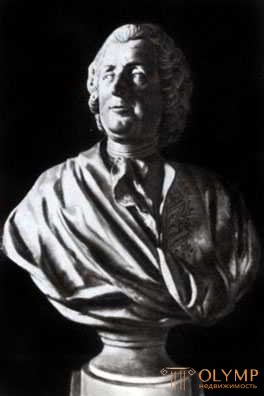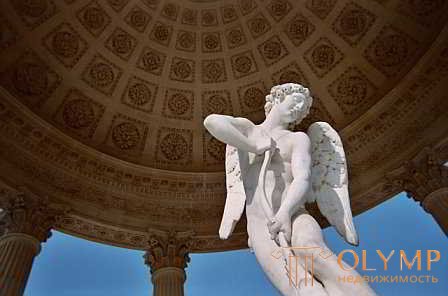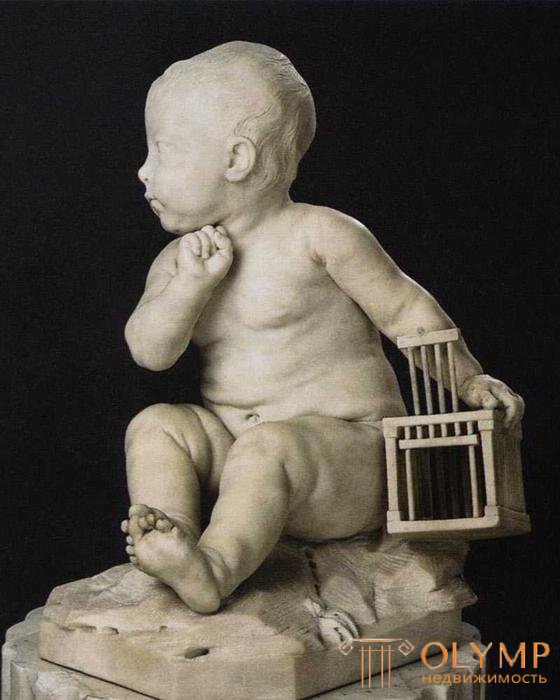
1. Classicism in sculpture
At the beginning of the 18th century, French sculpture developed within the framework of classicism and made a significant breakthrough in artistic strength and naturalness.
The strength of plastic transmission, the old French quality, did not change the French in the XVIII century. The thread of the tradition did not break. Generations of gifted sculptors followed one after another. The classicism of the century of Louis XIV in sculpture becomes more clearly the basis for further development than in architecture. If the rococo decoration also consisted mostly of sculptural carving, often with additions of love gods, then in the free plastic of the French of this era, the entire rococo movement is reflected only slightly and with vibrations, and the transitions from rococo to neoclassicism are only affected by light curves. The old habit of embodying thoughts and ideas in allegorical figures, especially on tombstones, remains in full force. Monarchs tend to make happy even the provincial cities with their copper or mounted horse portraits and the sculptors' tendency to create free works valuable in their own right. Most of the ideal figures of the French sculpture of this time still leaves the impression of some intention and mannerism, but the more perfect is the plastic portrait art of France. The best French sculptural works of the 18th century are portrait busts breathing amazing freshness and vitality. It is in them that the higher, technical mastery, which not only playfully expresses the matter of clothes, but also conveys the surface of a naked body with an unprecedented hitherto sophistication and softness, becomes usual.
The disciple of Lorrain was Jean Baptiste Lemoine (1704-1778), whom Gonz still calls the true heir to Bush's manner, and at the same time the "initiator" of the new art of sculpturing of the 18th century. His equestrian statue of Louis XV in Bordeaux, unfortunately, destroyed. But in the Louvre, a bronze model of his monument to this king for Rennes has been preserved. The master raised by the soldiers on the shield is here in the form of an ancient Roman warrior. The sculptor of perfect figures, still affected by a slightly baroque mood, is Lemoine in the group “Baptism of Christ” in Saint-Roch in Paris. Of his excellent portrait busts breathing in the individual life of the soul, we note the busts of actress Cleron in the French theater, Reaumur in the Botanical Garden and the architect Gabriel in the Louvre.

Fig. 204. Bust of the architect Gabriel by Jean Baptiste Lemoine in the Louvre.
The experiences of a Belgian baroque sculpture are discovered by Sebastien Slodts (circa 1655–1726), an Antwerp who was a student of Girardon in Paris. Its powerful, not particularly pleasant marble Hannibal stands in the Louvre. His son and pupil Michel Slodts (1705-1765) belongs half to the Roman school. After graduating from the academy of the eternal city, he performed the figures of saints and tombstones for Roman churches, but in 1747 he returned to Paris, where his best work appeared - the tombstone of Abbot de Gerzi in Saint Sulpice, made of marble and bronze. The kneeling figure of the deceased in the form of a round medallion is famous for its deep expression of pious humility.
Edmond Bouchardon (1698–1762) is considered the first true classic of the eighteenth century, a friend of Count Kailus, whose ideals he sought to realize. He is called the French Phidias. From his first teacher, Guillome Couste, he borrowed more smooth delights in the sense of the French XVIII century than is generally thought. His delightful, lively marble Cupid, carving a bow from the club of Hercules, located in the Louvre, stood originally in the round garden pavilion of the Petit Trianon. His best work - a pond on the street Grenelle in Paris. Architectural and sculptural forms are internally merged here, and the Seasons depicted in reliefs with children, although made more picturesquely, give the impression of already well-known examples, which could not be expected from the French Phidia. The magnificent, proportional equestrian statue of Louis XV Bouchardon, adorning the Place de la Concorde, is preserved only as a small bronze model in the Louvre.

Fig. 205. Cupid Edmond Bouchardon in the Louvre.

Fig. 206. "A boy with a cage." Sculpture of Jean Baptiste Pigalle in the Louvre.
Pigulla's brother-in-law Gabriel Christoph Allergen (1710–1795) is in his marble works, the Bather and the Diane of the Louvre, the master of a calmer, albeit more deliberate grace. Étienne-Maurice Falcone (1716–1791; Edm. Hildebrandt’s book), from which Louvre’s works “Divine Love” reflects the charm of the epoch’s style, and the subtlely felt “Bather” (1757) is still somewhat charmer, “Milon of Croton” surpasses the famous work Puzhe created the power of the movement and the wealth of lines for Russia in his illustrious equestrian statue of Peter the Great in St. Petersburg (since 1766), depicting a galloping horse on a granite rock that reared up on a cliff, one of the grandest sculptures of the century.
An important role in French sculpture was played further by Kafieri, of whom Jacques Caffieri (1678-1755) was a clever decorative and skillful portrait master. Of his sons, Philip Caffieri the Younger (1714–1744) is the master of the famous silver jewelery of the Bayeux Cathedral, and Jean Jacques Caffieri (1725–1792), the author of the gentle and flowing god of the river, is known mainly for his portraits. Of the busts that adorn the galleries of the French Theater, seven are his works. The busts of La Chaussee, Rothru and Jean Battista Rousseau are especially expressive.
2. Masters of the second half of the century
A number of outstanding sculptors, who continued to work at the beginning of the XIX century, made the connection between different eras in national sculpture. So, Louis Mishe (Clodion), who specialized in light decorative motifs, became one of the founders of the Empire style.
Of the French sculptors of the 18th century, stepping over in the nineteenth, we are especially fascinated by Paget, Claudion, and Houdon.
Augustin Paget (1730–1809) was to the disciples of Lemoine. His Pluto with a hell hound (1759) and the marble statue of Queen Maria Leschinskaya in the Louvre are superb but boring statues. Only in the marble Psyche and Bacchae of the same collection does the fervent, sometimes somewhat refined charm of his mature creations appear. The adorable sophisticated naturalness of his portrait art has an attractive effect on the marble busts of Buffon and Madame Du Barry in the Louvre.
The son-in-law of Pajou Louis Michès, surnamed Claudion (1738–1814), who was a pupil of Pigalle since 1759, was mainly engaged in the production of pretty, though somewhat equivocal, terracotta images of fauns, nymphs, etc .; from the same mood was born his marble group of bacchantes and his satyr in the Louvre. It is quite significant that the porcelain manufactory that emerged in Sevres invited him to serve. Known for his vase, decorated with playing children, in Sevres. He performed many decorative works for Parisian women. His relief, ten meters long, with the triumph of Galatea, Gonz saw in the courtyard of a house on the Place Vendome. Less happy was Clodion in more serious images, what are the pampered St. Cecilia and the Assumption of Mary (1777) in the Cathedral of Rouen. It is instructive that in his senile years, having already gone beyond the threshold of the XIX century, he still contributed to the turn to the Empire style. His main work of this kind is a relief depicting “Entry into Munich” at the triumphal gate of the Carusel Square. The taste of the era was stronger than the artist.
Что бы оставить комментарий войдите
Комментарии (0)